Secure Attachment: Confidence, Achievement, and Life Satisfaction
VerifiedAdded on 2023/06/08
|9
|2374
|481
Essay
AI Summary
This essay delves into the critical role of secure attachment in human development, exploring its influence from infancy through adulthood. The introduction establishes the foundation of attachment theory, emphasizing its impact on mental schemata and identity formation. The literature review highlights the enduring psychological state of attachment and its significance in fostering emotional security. The essay then examines how secure attachment contributes to successful relationship formations, emphasizing the development of love, passion, and compassion, which leads to adaptability and safe relationships. Furthermore, the essay explores the inextricable link between secure attachment and self-identity, illustrating how positive associations lay the foundation for normal identity development and self-esteem. The importance of secure attachment in building confidence and achieving life satisfaction is also discussed, including its impact on decision-making, motivation, and the ability to accomplish goals. The essay concludes by underscoring the enduring impact of secure attachments on individuals' overall well-being and social development, emphasizing the need for secure environments to facilitate effective physiological and psychological nourishment.

Running head: SECURE ATTACHMENT 1
Student Name
Institutional Affiliation
Secure Attachment
Student Name
Institutional Affiliation
Secure Attachment
Paraphrase This Document
Need a fresh take? Get an instant paraphrase of this document with our AI Paraphraser
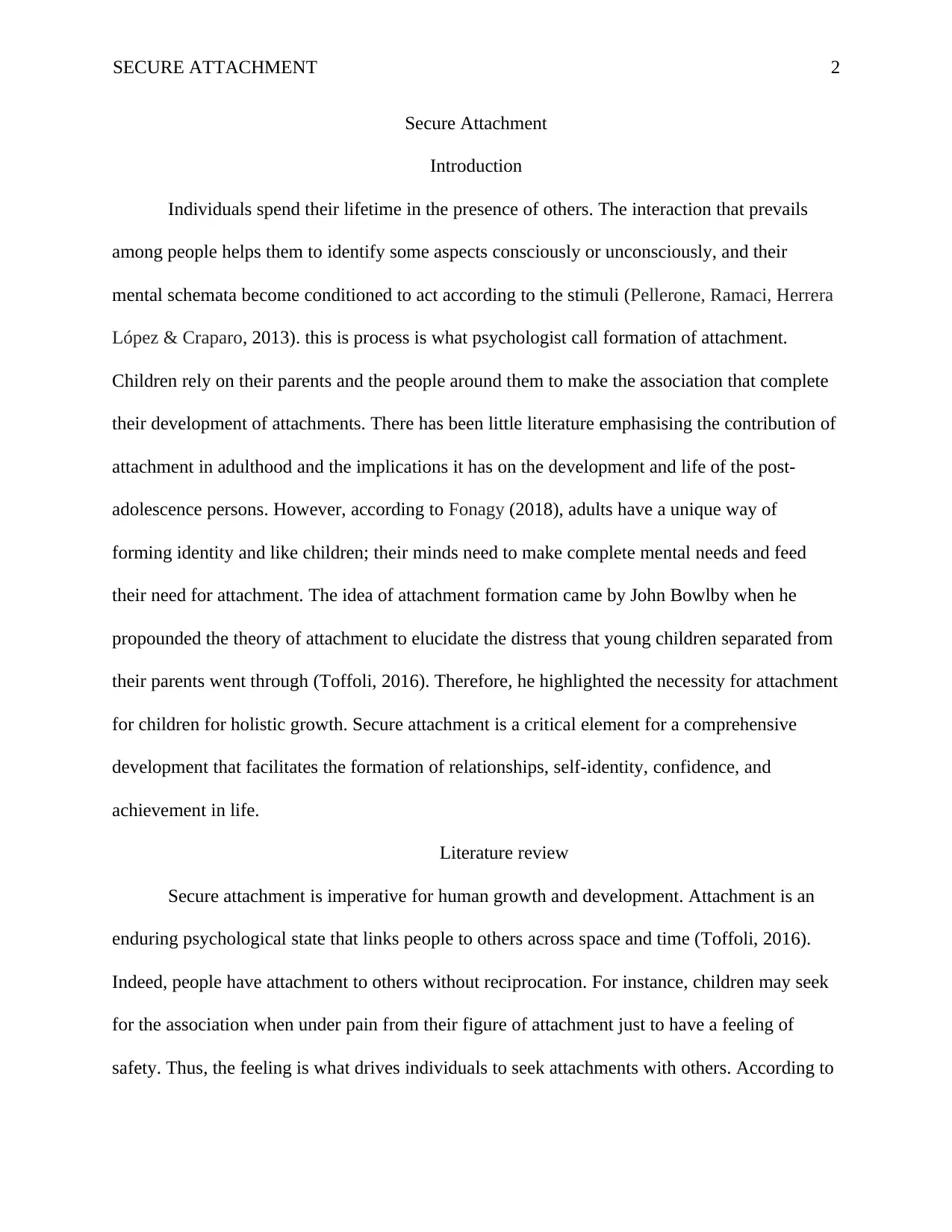
SECURE ATTACHMENT 2
Secure Attachment
Introduction
Individuals spend their lifetime in the presence of others. The interaction that prevails
among people helps them to identify some aspects consciously or unconsciously, and their
mental schemata become conditioned to act according to the stimuli (Pellerone, Ramaci, Herrera
López & Craparo, 2013). this is process is what psychologist call formation of attachment.
Children rely on their parents and the people around them to make the association that complete
their development of attachments. There has been little literature emphasising the contribution of
attachment in adulthood and the implications it has on the development and life of the post-
adolescence persons. However, according to Fonagy (2018), adults have a unique way of
forming identity and like children; their minds need to make complete mental needs and feed
their need for attachment. The idea of attachment formation came by John Bowlby when he
propounded the theory of attachment to elucidate the distress that young children separated from
their parents went through (Toffoli, 2016). Therefore, he highlighted the necessity for attachment
for children for holistic growth. Secure attachment is a critical element for a comprehensive
development that facilitates the formation of relationships, self-identity, confidence, and
achievement in life.
Literature review
Secure attachment is imperative for human growth and development. Attachment is an
enduring psychological state that links people to others across space and time (Toffoli, 2016).
Indeed, people have attachment to others without reciprocation. For instance, children may seek
for the association when under pain from their figure of attachment just to have a feeling of
safety. Thus, the feeling is what drives individuals to seek attachments with others. According to
Secure Attachment
Introduction
Individuals spend their lifetime in the presence of others. The interaction that prevails
among people helps them to identify some aspects consciously or unconsciously, and their
mental schemata become conditioned to act according to the stimuli (Pellerone, Ramaci, Herrera
López & Craparo, 2013). this is process is what psychologist call formation of attachment.
Children rely on their parents and the people around them to make the association that complete
their development of attachments. There has been little literature emphasising the contribution of
attachment in adulthood and the implications it has on the development and life of the post-
adolescence persons. However, according to Fonagy (2018), adults have a unique way of
forming identity and like children; their minds need to make complete mental needs and feed
their need for attachment. The idea of attachment formation came by John Bowlby when he
propounded the theory of attachment to elucidate the distress that young children separated from
their parents went through (Toffoli, 2016). Therefore, he highlighted the necessity for attachment
for children for holistic growth. Secure attachment is a critical element for a comprehensive
development that facilitates the formation of relationships, self-identity, confidence, and
achievement in life.
Literature review
Secure attachment is imperative for human growth and development. Attachment is an
enduring psychological state that links people to others across space and time (Toffoli, 2016).
Indeed, people have attachment to others without reciprocation. For instance, children may seek
for the association when under pain from their figure of attachment just to have a feeling of
safety. Thus, the feeling is what drives individuals to seek attachments with others. According to
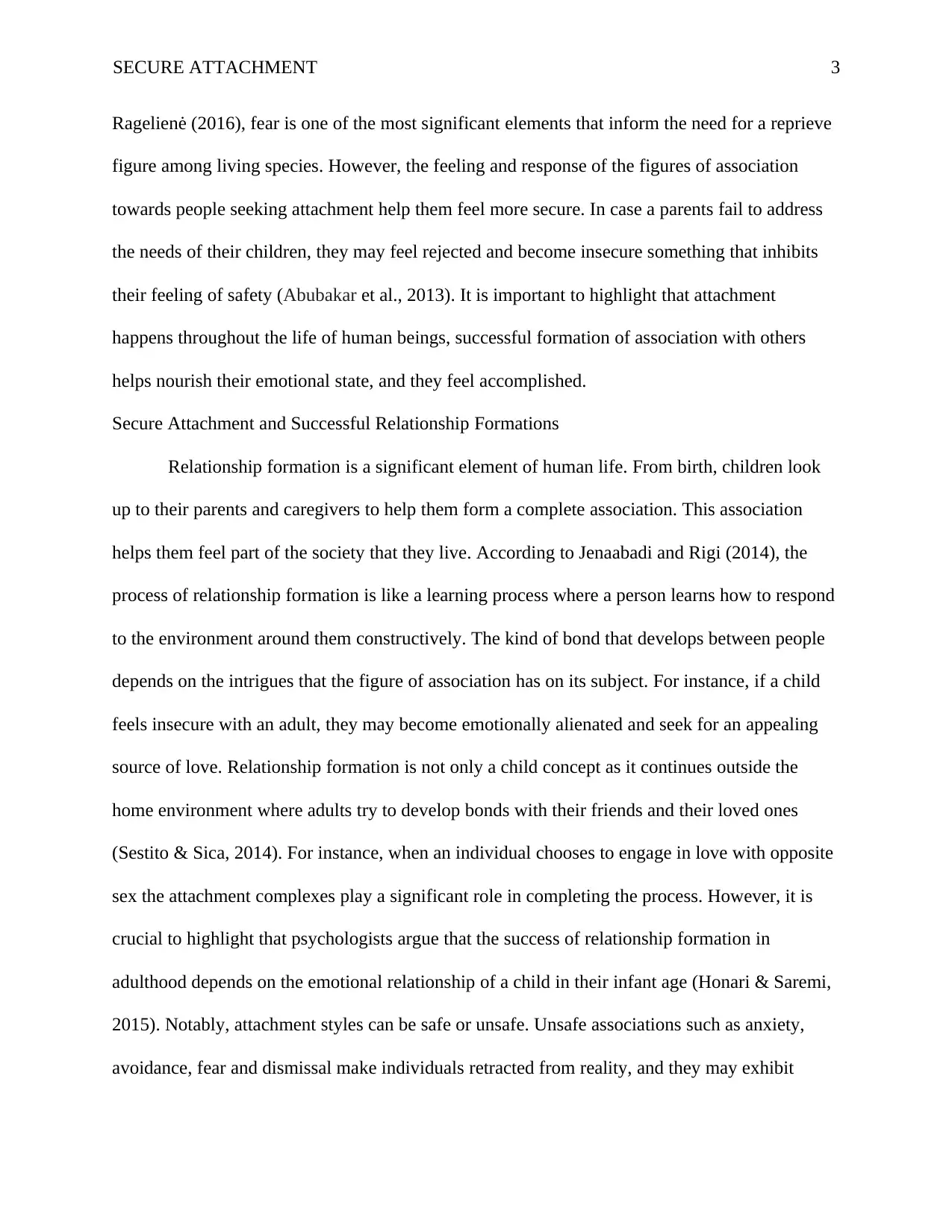
SECURE ATTACHMENT 3
Ragelienė (2016), fear is one of the most significant elements that inform the need for a reprieve
figure among living species. However, the feeling and response of the figures of association
towards people seeking attachment help them feel more secure. In case a parents fail to address
the needs of their children, they may feel rejected and become insecure something that inhibits
their feeling of safety (Abubakar et al., 2013). It is important to highlight that attachment
happens throughout the life of human beings, successful formation of association with others
helps nourish their emotional state, and they feel accomplished.
Secure Attachment and Successful Relationship Formations
Relationship formation is a significant element of human life. From birth, children look
up to their parents and caregivers to help them form a complete association. This association
helps them feel part of the society that they live. According to Jenaabadi and Rigi (2014), the
process of relationship formation is like a learning process where a person learns how to respond
to the environment around them constructively. The kind of bond that develops between people
depends on the intrigues that the figure of association has on its subject. For instance, if a child
feels insecure with an adult, they may become emotionally alienated and seek for an appealing
source of love. Relationship formation is not only a child concept as it continues outside the
home environment where adults try to develop bonds with their friends and their loved ones
(Sestito & Sica, 2014). For instance, when an individual chooses to engage in love with opposite
sex the attachment complexes play a significant role in completing the process. However, it is
crucial to highlight that psychologists argue that the success of relationship formation in
adulthood depends on the emotional relationship of a child in their infant age (Honari & Saremi,
2015). Notably, attachment styles can be safe or unsafe. Unsafe associations such as anxiety,
avoidance, fear and dismissal make individuals retracted from reality, and they may exhibit
Ragelienė (2016), fear is one of the most significant elements that inform the need for a reprieve
figure among living species. However, the feeling and response of the figures of association
towards people seeking attachment help them feel more secure. In case a parents fail to address
the needs of their children, they may feel rejected and become insecure something that inhibits
their feeling of safety (Abubakar et al., 2013). It is important to highlight that attachment
happens throughout the life of human beings, successful formation of association with others
helps nourish their emotional state, and they feel accomplished.
Secure Attachment and Successful Relationship Formations
Relationship formation is a significant element of human life. From birth, children look
up to their parents and caregivers to help them form a complete association. This association
helps them feel part of the society that they live. According to Jenaabadi and Rigi (2014), the
process of relationship formation is like a learning process where a person learns how to respond
to the environment around them constructively. The kind of bond that develops between people
depends on the intrigues that the figure of association has on its subject. For instance, if a child
feels insecure with an adult, they may become emotionally alienated and seek for an appealing
source of love. Relationship formation is not only a child concept as it continues outside the
home environment where adults try to develop bonds with their friends and their loved ones
(Sestito & Sica, 2014). For instance, when an individual chooses to engage in love with opposite
sex the attachment complexes play a significant role in completing the process. However, it is
crucial to highlight that psychologists argue that the success of relationship formation in
adulthood depends on the emotional relationship of a child in their infant age (Honari & Saremi,
2015). Notably, attachment styles can be safe or unsafe. Unsafe associations such as anxiety,
avoidance, fear and dismissal make individuals retracted from reality, and they may exhibit
⊘ This is a preview!⊘
Do you want full access?
Subscribe today to unlock all pages.

Trusted by 1+ million students worldwide
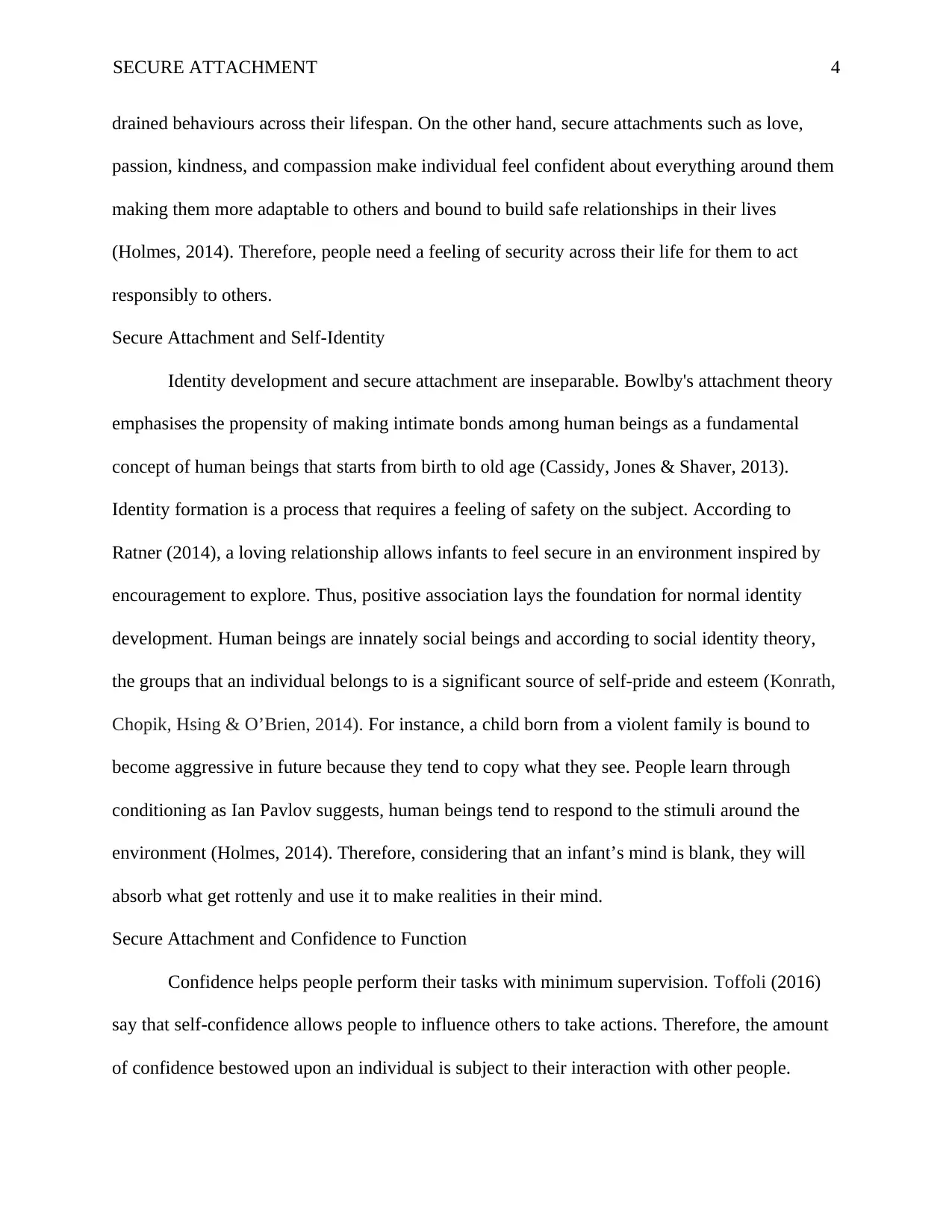
SECURE ATTACHMENT 4
drained behaviours across their lifespan. On the other hand, secure attachments such as love,
passion, kindness, and compassion make individual feel confident about everything around them
making them more adaptable to others and bound to build safe relationships in their lives
(Holmes, 2014). Therefore, people need a feeling of security across their life for them to act
responsibly to others.
Secure Attachment and Self-Identity
Identity development and secure attachment are inseparable. Bowlby's attachment theory
emphasises the propensity of making intimate bonds among human beings as a fundamental
concept of human beings that starts from birth to old age (Cassidy, Jones & Shaver, 2013).
Identity formation is a process that requires a feeling of safety on the subject. According to
Ratner (2014), a loving relationship allows infants to feel secure in an environment inspired by
encouragement to explore. Thus, positive association lays the foundation for normal identity
development. Human beings are innately social beings and according to social identity theory,
the groups that an individual belongs to is a significant source of self-pride and esteem (Konrath,
Chopik, Hsing & O’Brien, 2014). For instance, a child born from a violent family is bound to
become aggressive in future because they tend to copy what they see. People learn through
conditioning as Ian Pavlov suggests, human beings tend to respond to the stimuli around the
environment (Holmes, 2014). Therefore, considering that an infant’s mind is blank, they will
absorb what get rottenly and use it to make realities in their mind.
Secure Attachment and Confidence to Function
Confidence helps people perform their tasks with minimum supervision. Toffoli (2016)
say that self-confidence allows people to influence others to take actions. Therefore, the amount
of confidence bestowed upon an individual is subject to their interaction with other people.
drained behaviours across their lifespan. On the other hand, secure attachments such as love,
passion, kindness, and compassion make individual feel confident about everything around them
making them more adaptable to others and bound to build safe relationships in their lives
(Holmes, 2014). Therefore, people need a feeling of security across their life for them to act
responsibly to others.
Secure Attachment and Self-Identity
Identity development and secure attachment are inseparable. Bowlby's attachment theory
emphasises the propensity of making intimate bonds among human beings as a fundamental
concept of human beings that starts from birth to old age (Cassidy, Jones & Shaver, 2013).
Identity formation is a process that requires a feeling of safety on the subject. According to
Ratner (2014), a loving relationship allows infants to feel secure in an environment inspired by
encouragement to explore. Thus, positive association lays the foundation for normal identity
development. Human beings are innately social beings and according to social identity theory,
the groups that an individual belongs to is a significant source of self-pride and esteem (Konrath,
Chopik, Hsing & O’Brien, 2014). For instance, a child born from a violent family is bound to
become aggressive in future because they tend to copy what they see. People learn through
conditioning as Ian Pavlov suggests, human beings tend to respond to the stimuli around the
environment (Holmes, 2014). Therefore, considering that an infant’s mind is blank, they will
absorb what get rottenly and use it to make realities in their mind.
Secure Attachment and Confidence to Function
Confidence helps people perform their tasks with minimum supervision. Toffoli (2016)
say that self-confidence allows people to influence others to take actions. Therefore, the amount
of confidence bestowed upon an individual is subject to their interaction with other people.
Paraphrase This Document
Need a fresh take? Get an instant paraphrase of this document with our AI Paraphraser
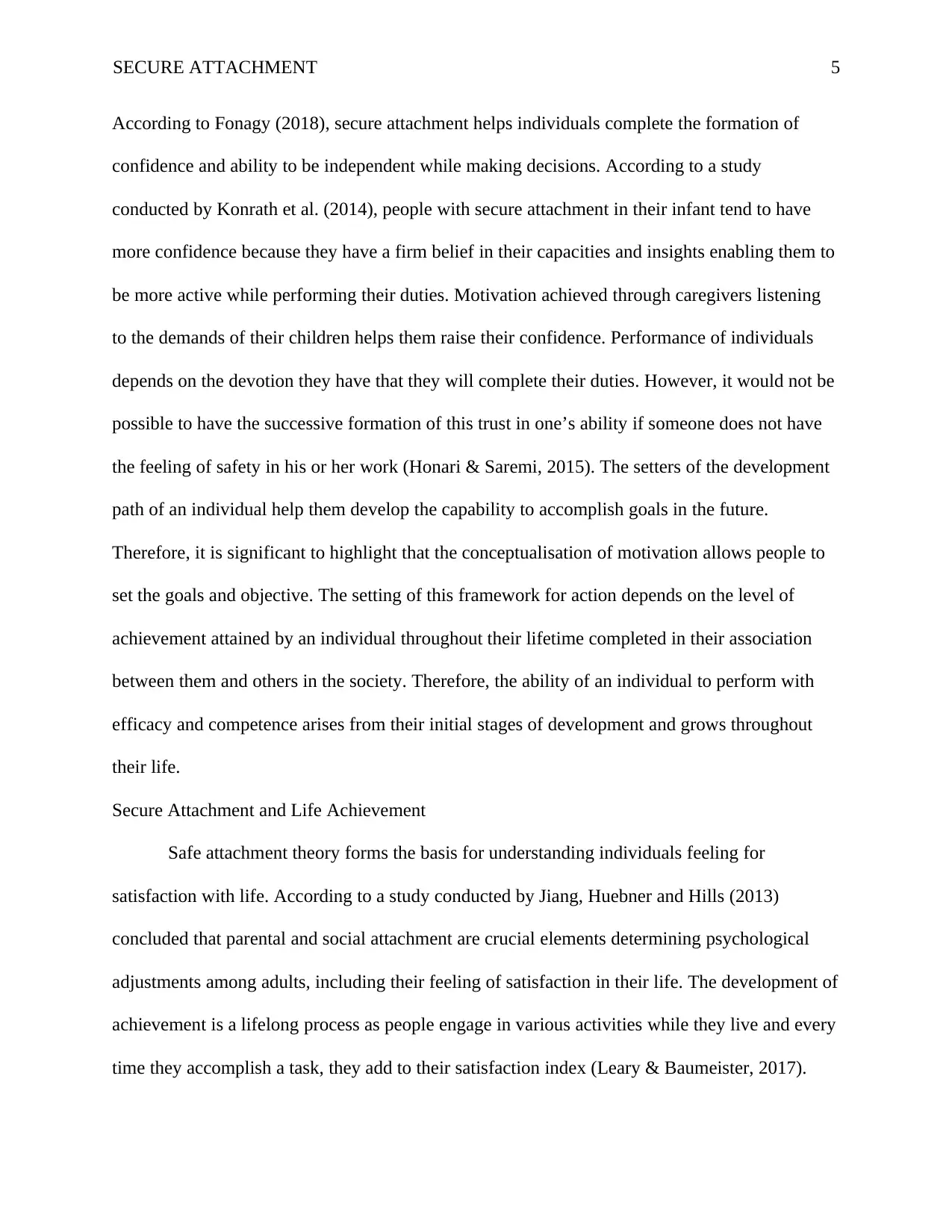
SECURE ATTACHMENT 5
According to Fonagy (2018), secure attachment helps individuals complete the formation of
confidence and ability to be independent while making decisions. According to a study
conducted by Konrath et al. (2014), people with secure attachment in their infant tend to have
more confidence because they have a firm belief in their capacities and insights enabling them to
be more active while performing their duties. Motivation achieved through caregivers listening
to the demands of their children helps them raise their confidence. Performance of individuals
depends on the devotion they have that they will complete their duties. However, it would not be
possible to have the successive formation of this trust in one’s ability if someone does not have
the feeling of safety in his or her work (Honari & Saremi, 2015). The setters of the development
path of an individual help them develop the capability to accomplish goals in the future.
Therefore, it is significant to highlight that the conceptualisation of motivation allows people to
set the goals and objective. The setting of this framework for action depends on the level of
achievement attained by an individual throughout their lifetime completed in their association
between them and others in the society. Therefore, the ability of an individual to perform with
efficacy and competence arises from their initial stages of development and grows throughout
their life.
Secure Attachment and Life Achievement
Safe attachment theory forms the basis for understanding individuals feeling for
satisfaction with life. According to a study conducted by Jiang, Huebner and Hills (2013)
concluded that parental and social attachment are crucial elements determining psychological
adjustments among adults, including their feeling of satisfaction in their life. The development of
achievement is a lifelong process as people engage in various activities while they live and every
time they accomplish a task, they add to their satisfaction index (Leary & Baumeister, 2017).
According to Fonagy (2018), secure attachment helps individuals complete the formation of
confidence and ability to be independent while making decisions. According to a study
conducted by Konrath et al. (2014), people with secure attachment in their infant tend to have
more confidence because they have a firm belief in their capacities and insights enabling them to
be more active while performing their duties. Motivation achieved through caregivers listening
to the demands of their children helps them raise their confidence. Performance of individuals
depends on the devotion they have that they will complete their duties. However, it would not be
possible to have the successive formation of this trust in one’s ability if someone does not have
the feeling of safety in his or her work (Honari & Saremi, 2015). The setters of the development
path of an individual help them develop the capability to accomplish goals in the future.
Therefore, it is significant to highlight that the conceptualisation of motivation allows people to
set the goals and objective. The setting of this framework for action depends on the level of
achievement attained by an individual throughout their lifetime completed in their association
between them and others in the society. Therefore, the ability of an individual to perform with
efficacy and competence arises from their initial stages of development and grows throughout
their life.
Secure Attachment and Life Achievement
Safe attachment theory forms the basis for understanding individuals feeling for
satisfaction with life. According to a study conducted by Jiang, Huebner and Hills (2013)
concluded that parental and social attachment are crucial elements determining psychological
adjustments among adults, including their feeling of satisfaction in their life. The development of
achievement is a lifelong process as people engage in various activities while they live and every
time they accomplish a task, they add to their satisfaction index (Leary & Baumeister, 2017).
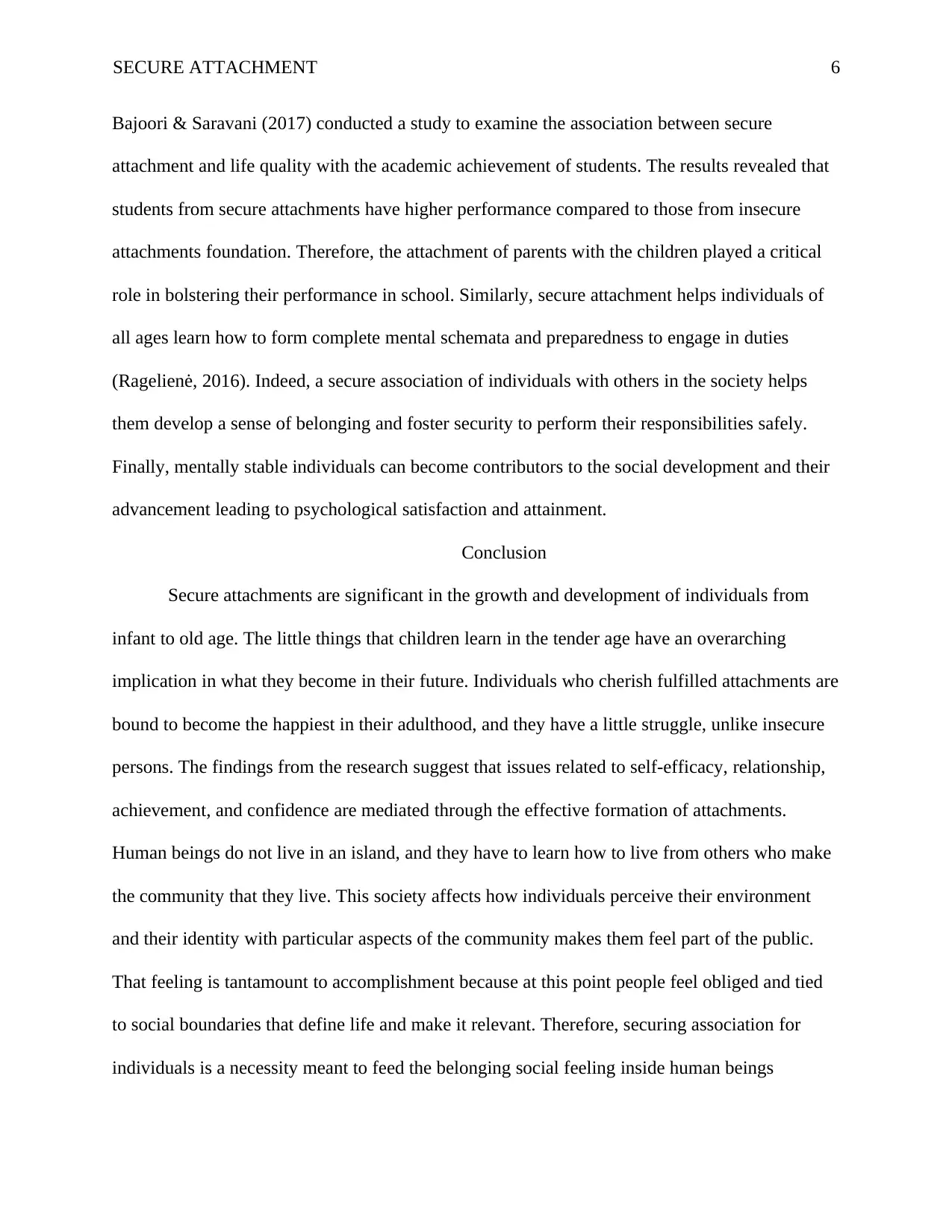
SECURE ATTACHMENT 6
Bajoori & Saravani (2017) conducted a study to examine the association between secure
attachment and life quality with the academic achievement of students. The results revealed that
students from secure attachments have higher performance compared to those from insecure
attachments foundation. Therefore, the attachment of parents with the children played a critical
role in bolstering their performance in school. Similarly, secure attachment helps individuals of
all ages learn how to form complete mental schemata and preparedness to engage in duties
(Ragelienė, 2016). Indeed, a secure association of individuals with others in the society helps
them develop a sense of belonging and foster security to perform their responsibilities safely.
Finally, mentally stable individuals can become contributors to the social development and their
advancement leading to psychological satisfaction and attainment.
Conclusion
Secure attachments are significant in the growth and development of individuals from
infant to old age. The little things that children learn in the tender age have an overarching
implication in what they become in their future. Individuals who cherish fulfilled attachments are
bound to become the happiest in their adulthood, and they have a little struggle, unlike insecure
persons. The findings from the research suggest that issues related to self-efficacy, relationship,
achievement, and confidence are mediated through the effective formation of attachments.
Human beings do not live in an island, and they have to learn how to live from others who make
the community that they live. This society affects how individuals perceive their environment
and their identity with particular aspects of the community makes them feel part of the public.
That feeling is tantamount to accomplishment because at this point people feel obliged and tied
to social boundaries that define life and make it relevant. Therefore, securing association for
individuals is a necessity meant to feed the belonging social feeling inside human beings
Bajoori & Saravani (2017) conducted a study to examine the association between secure
attachment and life quality with the academic achievement of students. The results revealed that
students from secure attachments have higher performance compared to those from insecure
attachments foundation. Therefore, the attachment of parents with the children played a critical
role in bolstering their performance in school. Similarly, secure attachment helps individuals of
all ages learn how to form complete mental schemata and preparedness to engage in duties
(Ragelienė, 2016). Indeed, a secure association of individuals with others in the society helps
them develop a sense of belonging and foster security to perform their responsibilities safely.
Finally, mentally stable individuals can become contributors to the social development and their
advancement leading to psychological satisfaction and attainment.
Conclusion
Secure attachments are significant in the growth and development of individuals from
infant to old age. The little things that children learn in the tender age have an overarching
implication in what they become in their future. Individuals who cherish fulfilled attachments are
bound to become the happiest in their adulthood, and they have a little struggle, unlike insecure
persons. The findings from the research suggest that issues related to self-efficacy, relationship,
achievement, and confidence are mediated through the effective formation of attachments.
Human beings do not live in an island, and they have to learn how to live from others who make
the community that they live. This society affects how individuals perceive their environment
and their identity with particular aspects of the community makes them feel part of the public.
That feeling is tantamount to accomplishment because at this point people feel obliged and tied
to social boundaries that define life and make it relevant. Therefore, securing association for
individuals is a necessity meant to feed the belonging social feeling inside human beings
⊘ This is a preview!⊘
Do you want full access?
Subscribe today to unlock all pages.

Trusted by 1+ million students worldwide

SECURE ATTACHMENT 7
genetics. Consequently, the society needs to help individuals realise secure attachments to
facilitate effective physiological and psychological nourishment.
genetics. Consequently, the society needs to help individuals realise secure attachments to
facilitate effective physiological and psychological nourishment.
Paraphrase This Document
Need a fresh take? Get an instant paraphrase of this document with our AI Paraphraser
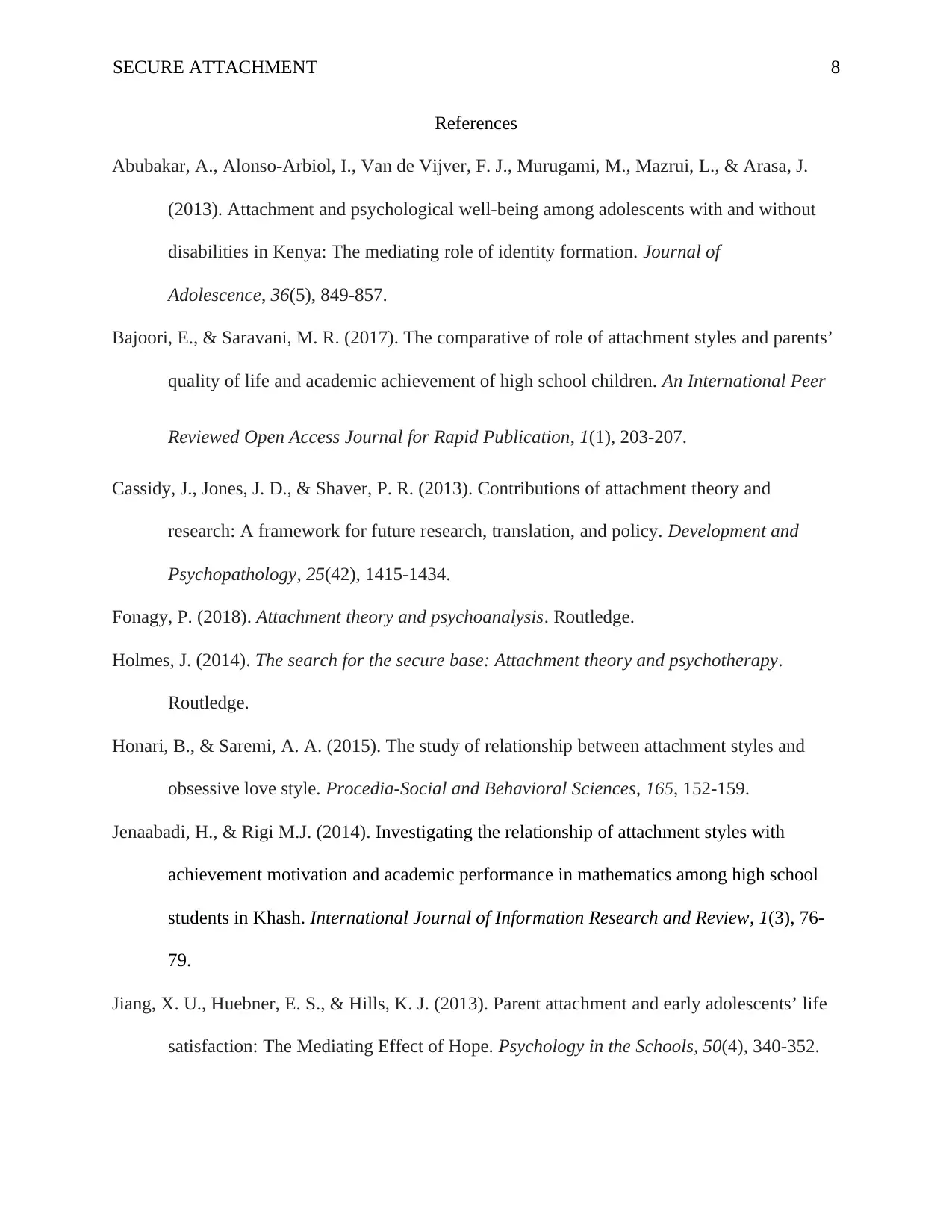
SECURE ATTACHMENT 8
References
Abubakar, A., Alonso-Arbiol, I., Van de Vijver, F. J., Murugami, M., Mazrui, L., & Arasa, J.
(2013). Attachment and psychological well-being among adolescents with and without
disabilities in Kenya: The mediating role of identity formation. Journal of
Adolescence, 36(5), 849-857.
Bajoori, E., & Saravani, M. R. (2017). The comparative of role of attachment styles and parents’
quality of life and academic achievement of high school children. An International Peer
Reviewed Open Access Journal for Rapid Publication, 1(1), 203-207.
Cassidy, J., Jones, J. D., & Shaver, P. R. (2013). Contributions of attachment theory and
research: A framework for future research, translation, and policy. Development and
Psychopathology, 25(42), 1415-1434.
Fonagy, P. (2018). Attachment theory and psychoanalysis. Routledge.
Holmes, J. (2014). The search for the secure base: Attachment theory and psychotherapy.
Routledge.
Honari, B., & Saremi, A. A. (2015). The study of relationship between attachment styles and
obsessive love style. Procedia-Social and Behavioral Sciences, 165, 152-159.
Jenaabadi, H., & Rigi M.J. (2014). Investigating the relationship of attachment styles with
achievement motivation and academic performance in mathematics among high school
students in Khash. International Journal of Information Research and Review, 1(3), 76-
79.
Jiang, X. U., Huebner, E. S., & Hills, K. J. (2013). Parent attachment and early adolescents’ life
satisfaction: The Mediating Effect of Hope. Psychology in the Schools, 50(4), 340-352.
References
Abubakar, A., Alonso-Arbiol, I., Van de Vijver, F. J., Murugami, M., Mazrui, L., & Arasa, J.
(2013). Attachment and psychological well-being among adolescents with and without
disabilities in Kenya: The mediating role of identity formation. Journal of
Adolescence, 36(5), 849-857.
Bajoori, E., & Saravani, M. R. (2017). The comparative of role of attachment styles and parents’
quality of life and academic achievement of high school children. An International Peer
Reviewed Open Access Journal for Rapid Publication, 1(1), 203-207.
Cassidy, J., Jones, J. D., & Shaver, P. R. (2013). Contributions of attachment theory and
research: A framework for future research, translation, and policy. Development and
Psychopathology, 25(42), 1415-1434.
Fonagy, P. (2018). Attachment theory and psychoanalysis. Routledge.
Holmes, J. (2014). The search for the secure base: Attachment theory and psychotherapy.
Routledge.
Honari, B., & Saremi, A. A. (2015). The study of relationship between attachment styles and
obsessive love style. Procedia-Social and Behavioral Sciences, 165, 152-159.
Jenaabadi, H., & Rigi M.J. (2014). Investigating the relationship of attachment styles with
achievement motivation and academic performance in mathematics among high school
students in Khash. International Journal of Information Research and Review, 1(3), 76-
79.
Jiang, X. U., Huebner, E. S., & Hills, K. J. (2013). Parent attachment and early adolescents’ life
satisfaction: The Mediating Effect of Hope. Psychology in the Schools, 50(4), 340-352.
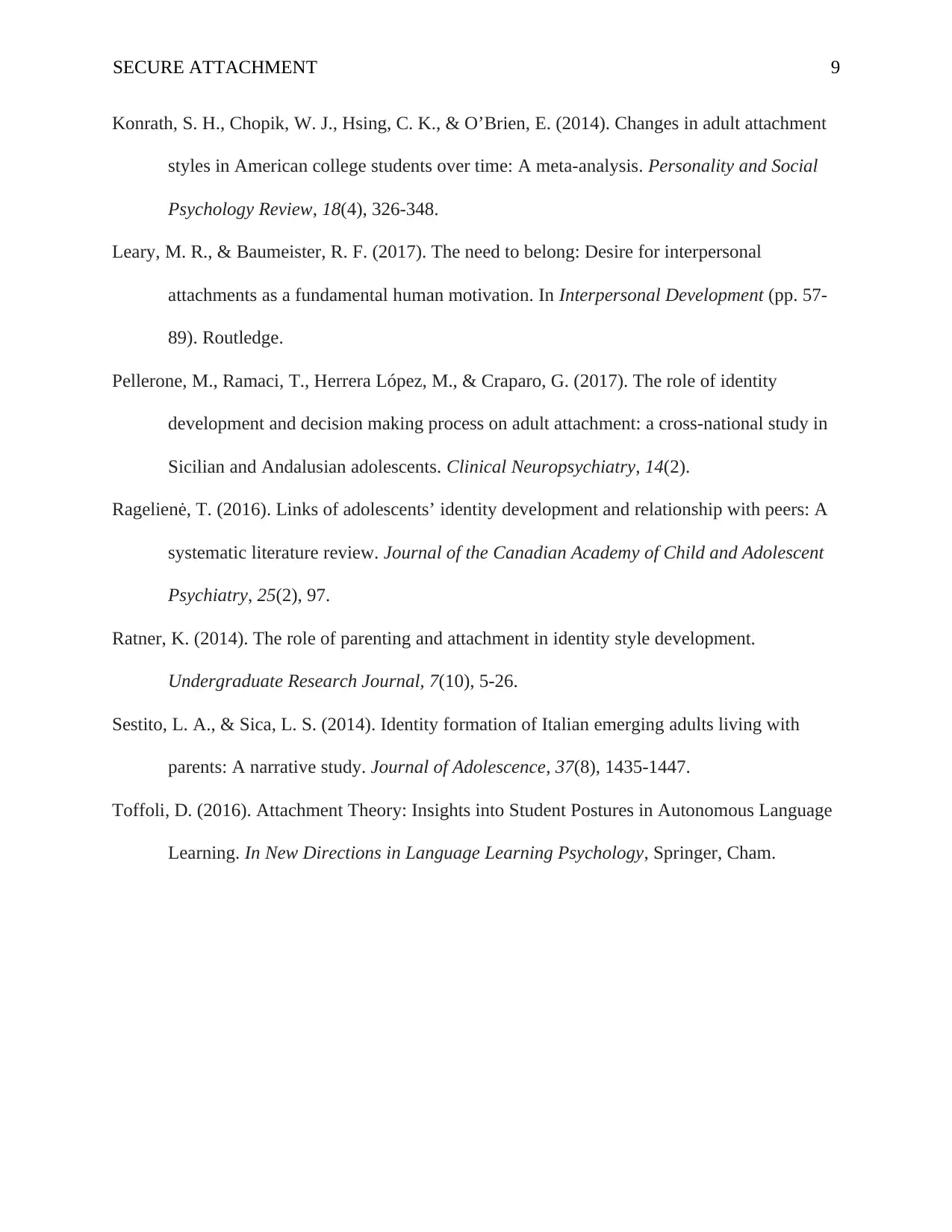
SECURE ATTACHMENT 9
Konrath, S. H., Chopik, W. J., Hsing, C. K., & O’Brien, E. (2014). Changes in adult attachment
styles in American college students over time: A meta-analysis. Personality and Social
Psychology Review, 18(4), 326-348.
Leary, M. R., & Baumeister, R. F. (2017). The need to belong: Desire for interpersonal
attachments as a fundamental human motivation. In Interpersonal Development (pp. 57-
89). Routledge.
Pellerone, M., Ramaci, T., Herrera López, M., & Craparo, G. (2017). The role of identity
development and decision making process on adult attachment: a cross-national study in
Sicilian and Andalusian adolescents. Clinical Neuropsychiatry, 14(2).
Ragelienė, T. (2016). Links of adolescents’ identity development and relationship with peers: A
systematic literature review. Journal of the Canadian Academy of Child and Adolescent
Psychiatry, 25(2), 97.
Ratner, K. (2014). The role of parenting and attachment in identity style development.
Undergraduate Research Journal, 7(10), 5-26.
Sestito, L. A., & Sica, L. S. (2014). Identity formation of Italian emerging adults living with
parents: A narrative study. Journal of Adolescence, 37(8), 1435-1447.
Toffoli, D. (2016). Attachment Theory: Insights into Student Postures in Autonomous Language
Learning. In New Directions in Language Learning Psychology, Springer, Cham.
Konrath, S. H., Chopik, W. J., Hsing, C. K., & O’Brien, E. (2014). Changes in adult attachment
styles in American college students over time: A meta-analysis. Personality and Social
Psychology Review, 18(4), 326-348.
Leary, M. R., & Baumeister, R. F. (2017). The need to belong: Desire for interpersonal
attachments as a fundamental human motivation. In Interpersonal Development (pp. 57-
89). Routledge.
Pellerone, M., Ramaci, T., Herrera López, M., & Craparo, G. (2017). The role of identity
development and decision making process on adult attachment: a cross-national study in
Sicilian and Andalusian adolescents. Clinical Neuropsychiatry, 14(2).
Ragelienė, T. (2016). Links of adolescents’ identity development and relationship with peers: A
systematic literature review. Journal of the Canadian Academy of Child and Adolescent
Psychiatry, 25(2), 97.
Ratner, K. (2014). The role of parenting and attachment in identity style development.
Undergraduate Research Journal, 7(10), 5-26.
Sestito, L. A., & Sica, L. S. (2014). Identity formation of Italian emerging adults living with
parents: A narrative study. Journal of Adolescence, 37(8), 1435-1447.
Toffoli, D. (2016). Attachment Theory: Insights into Student Postures in Autonomous Language
Learning. In New Directions in Language Learning Psychology, Springer, Cham.
⊘ This is a preview!⊘
Do you want full access?
Subscribe today to unlock all pages.

Trusted by 1+ million students worldwide
1 out of 9
Related Documents
Your All-in-One AI-Powered Toolkit for Academic Success.
+13062052269
info@desklib.com
Available 24*7 on WhatsApp / Email
![[object Object]](/_next/static/media/star-bottom.7253800d.svg)
Unlock your academic potential
Copyright © 2020–2025 A2Z Services. All Rights Reserved. Developed and managed by ZUCOL.





